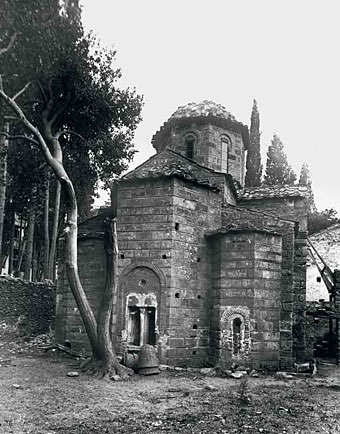
 |
 |
 |
 |
Type: Cross-in-Square
Date: 2nd half of the 11th century
Description:
In the valley in the middle of the western slope of Hymettus, in the archeological site lies the Monastery of Kaisariani. It is a semi-complex, four-columned, cross-in-square church, which is dated to the second half of the 11th century. However, Professor Bouras claims that it could be dated to the 12th century. Its masonry is cloisonné. During the years of the Turkish domination, the chapel of Hagios Antonios was attached in the south of the katholicon, while a narthex was added in the west. The wall paintings of the katholicon are more recent, dated to the beginnings of the 18th century. The wall paintings of the narthex (painted by Ioannis Ipatos according to an inscription in situ) are dated in 1682. Apart from the katholicon, a bath is preserved in the south of the chapel from the Byzantine phase of the monastery (initially it was a triconch building with a semi-circular dome). An air-duct system and piers were revealed in its walls. The other buildings in the west and the southwest of the kátholicon (Refectory, Cells) are dated to the years of the Turkish rule. The origin of the name Kaisariani is not scientifically documented. According to a theory, this name originates from its founder, a certain Kaisarios, or from Caesars, the emperor’s brothers, who were exiled in Athens by the Athenian empress Irene. According to another theory, it was such named after an icon of the Virgin Mary, which came from Kaisareia (the Monastery is dedicated to the Presentation of the Virgin Mary). Its name is mentioned in 1209 in an epistle of Michael Choniates, who was self exiled in Kea, to the abbot of the Monastery. It is also mentioned as Santa Syriani in a document of Pope Innocent III.
In the north of the Monastery lies the spring which was mentioned in sources as Killou Pera, Kouloupera, Koukloupera, or Kallia Pera. Today’s name Kalopoula is a corruption of this word. Moreover, close to the eastern entrance of the Monastery lies Kriokefali spring, while the holy water of the Ascension of Christ is found two hundred meters southeast.
However, the first Christian center was not in the position of the Byzantine Monastery, but in the position “Cemetery of the Holy Fathers”, in the southwest of the monastery. Nowadays, in this position are preserved the remnants of an early Christian basilica of the 5th – 6th century, where another church was built in the 10th century. During the years of the Frankish rule, the catholic church of Hagios Markos was built in the south of the church. The name Frangomonastiro derives from this church. The present church, which is situated in the west of the remnants of these churches, is the more recent (17th century) church of Taxiarches.
Hamilton J.A., The Church of Kaisariani in Athens, Aberdeen 1916.







